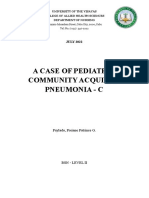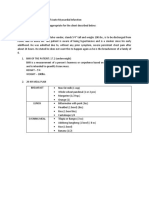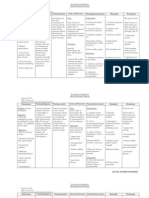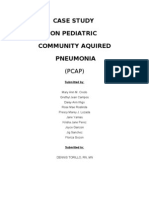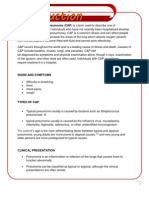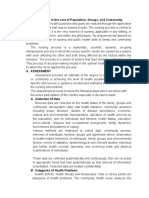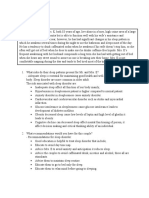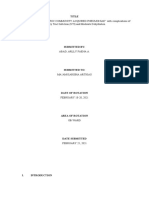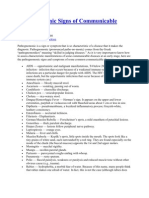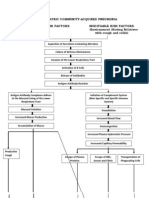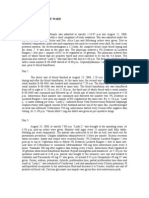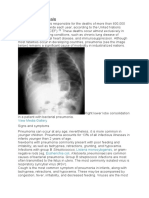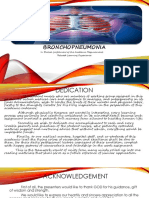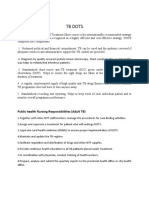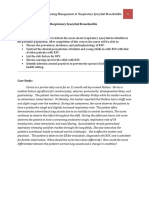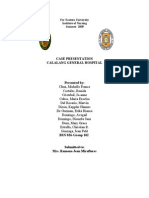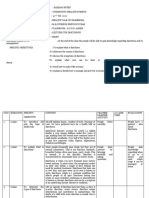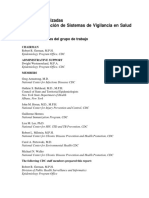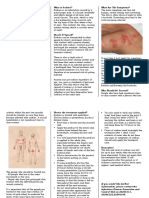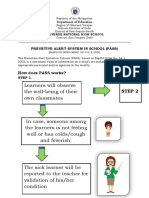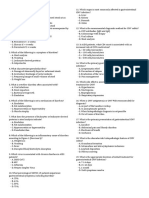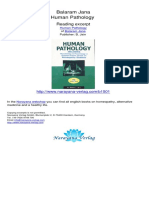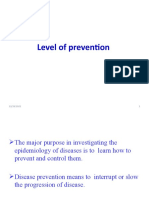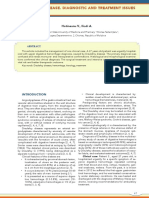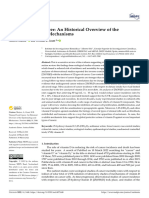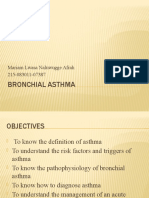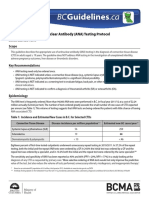Final Intro PCAP C
Final Intro PCAP C
Uploaded by
kelsey_dobleCopyright:
Available Formats
Final Intro PCAP C
Final Intro PCAP C
Uploaded by
kelsey_dobleOriginal Description:
Copyright
Available Formats
Share this document
Did you find this document useful?
Is this content inappropriate?
Copyright:
Available Formats
Final Intro PCAP C
Final Intro PCAP C
Uploaded by
kelsey_dobleCopyright:
Available Formats
This is a case of 7-year-old boy who was diagnosed of having a Pediatric Community Acquired Pneumonia-Type C.
Pediatric Community Acquired Pneumonia (PCAP) refers to pneumonia in a previously healthy person who acquired the infection outside a hospital. PCAP is a common illness that affects infants and children. In children, the majority of deaths occur in the newborn period, with over two million worldwide deaths a year. In fact, the WHO estimates that one in a three newborn infant deaths are due to pneumonia. It occurs because the areas of the lung which absorb oxygen (alveoli) from the atmosphere become filled with fluid and cannot work effectively. Children are very susceptible to acquire this illness especially when their immune systems are low. They can get it anywhere like in school, for example, one of the classmates has a cough. Then in house, if there is a poor environment. Then in playground, wherein there are lots of other children playing. PCAP is classified into four types. First is, PCAP A, which has a minimal risk, there is no dehydration, with a respiratory rate of greater than 30-50/min. Second is, PCAP B, which has a low risk, there is mild dehydration, with a respiratory rate of greater than 30-50/min. Third is, PCAP C, which has a moderate risk, with moderate dehydration, with a respiratory rate of greater than 35-60/min. Fourth is, PCAP D, which has a high risk, with severe dehydration, with a respiratory rate of greater than 35-70/min. But in this case, our patient has a PCAP C. Pneumonia is sometimes caused by viral infections, including RSV, the parainfluenzavirus, adenovirus, and the flu. In addition to viruses, pneumonia can also be caused by bacteria, including S. pneumoniae, H, influenza type b, groupA streptococcus, and M. tuberculosis (TB). Some of the symptoms of PCAP are fever, cough, tachypnea, grunting and audible wheezing, chest pain, and it is often proceeded by upper respiratory tract infection. It can be diagnosed by chest x-ray, blood tests, sputum culture, pulse oximetry, chest CT scan, bronchoscopy, and pleural fluid culture. The best way to prevent PCAP is to cover mouth when coughing, practice good hygiene, and have a clean environment. Also, childhood immunizations willhelp greatly in the prevention of PCAP in children. Treating pneumonia includes appropriate diet, increase fluid intake, cool mist humidifier in the childs room, medication for cough, intravenous (IV) fluids or oral antibiotics, oxygen therapy, frequent suctioning of the childs nose and mouth (to help get rid of thick secretions), and breathing treatments, as ordered by the childs doctor. In 2009, 1.1 million people in the United States were hospitalized with pneumonia and more than 50,000 people died from the disease. Globally, pneumonia kills more than 1.5 million children younger than 5 years of age each year. This is greater than the number of deaths from any other infectious disease, such as AIDS, malaria or tuberculosis (Center for Disease Control and 1
Prevention). In the Philippines, there are more than 40,000 cases of CAP annually. More than 50% are admitted in the hospital. Pneumonia is considered the 3rd leading cause of death and the 4th leading cause of morbidity in children (Department of Health, 2008 Health Statistics). The significance of this study globally is, since other countries are already updated, this study will give more information to them on the previous studies about PCAP. Nationally, to increase awareness thus will lead them to be prepared in case the number of PCAP cases will increase. Locally, this will help in treating and preventing the spread of PCAP here in Batangas. We chose this study because as nursing students we would like to increase our knowledge about this illness. As part of our duty the right interventions are needed in order to help the patient and we will only be able to do it by studying this case more deeply.
General Objectives: After this case study, we will be able to know what Pediatric Community Acquired Pneumonia, how it is acquired and, its prevention and treatment of its occurrence. Specific Objectives: Define what is PCAP-C Trace the pathophysiology of PCAP-C Enumerate the causes and symptoms of PCAP-C Formulate and apply nursing care plans, utilizing the nursing process To learn new clinical skills as well as sharpen our current clinical skills required in the management of the patient with PCAP-C To develop our sense of love and empathy in rendering nursing care to our patient so that we may be able to serve future clients with higher level of holistic understanding as well as individualized care.
Name: K.U. Age: 7 y/o Address: Luta Norte, Malvar, Batangas Status: Child Educational Attainment: Level 1 Occupation: N/A Chief complaint: Cough for 2 weeks Admitting Dx: Pediatric Community Acquired Pneumonia Type C (PCAP-C) Present Dx:Pediatric Community Acquired Pneumonia Type C (PCAP-C) Date and Time of Admission: 12/08/12 3:00 PM Attending Doctor: Dr. Geraldine Dimaculangan
You might also like
- Nursing Care Plan Community Acquired PneumoniaDocument2 pagesNursing Care Plan Community Acquired Pneumoniaderic92% (50)
- NCP (Appendicitis)Document3 pagesNCP (Appendicitis)Jenny Ajoc100% (2)
- Pathophysiology of Pediatric Community Acquired PneumoniaDocument2 pagesPathophysiology of Pediatric Community Acquired PneumoniaKeij AranetaNo ratings yet
- Focus ChartingDocument23 pagesFocus ChartingMarianne GonzalesNo ratings yet
- A Case of PCAP-C (Individual INP)Document44 pagesA Case of PCAP-C (Individual INP)Preiane PayladoNo ratings yet
- PCAP-c Group A NiggasDocument39 pagesPCAP-c Group A NiggasJenny YenNo ratings yet
- Pediatric Community Acquired Pneumonia (PCAP)Document24 pagesPediatric Community Acquired Pneumonia (PCAP)deejayseroje93% (29)
- PCAP CDocument42 pagesPCAP CJenny YenNo ratings yet
- Case Study PN Pcap C FinalDocument50 pagesCase Study PN Pcap C FinalKimberly Milaran33% (3)
- Week 3 Course TaskDocument1 pageWeek 3 Course Tasklyka resurreccionNo ratings yet
- Cap NCPDocument6 pagesCap NCPMarlo Parayno100% (2)
- Epidemiology Quiz On Chapter 1Document3 pagesEpidemiology Quiz On Chapter 1drng48No ratings yet
- Pneumonia Case Pres Level 2 Group 4Document43 pagesPneumonia Case Pres Level 2 Group 4Archie Punzalan67% (3)
- PCAP CPDocument14 pagesPCAP CPMikael R. SmileNo ratings yet
- UMTC PCAP - C Case StudyDocument17 pagesUMTC PCAP - C Case StudyMary Ann Credo Manlangit67% (3)
- Journal Pcap CDocument3 pagesJournal Pcap CKit Lara50% (2)
- Evaluation Examination For Medicine WardDocument3 pagesEvaluation Examination For Medicine WardMarvick GalimaNo ratings yet
- NCP PcapDocument2 pagesNCP PcapKenj Pereña100% (1)
- Nursing Care Plan For PcapDocument6 pagesNursing Care Plan For PcapMadsNo ratings yet
- Capitol University: College of Nursing Cagayan de Oro CityDocument2 pagesCapitol University: College of Nursing Cagayan de Oro CityChaine Agolito100% (1)
- Patterns of Occurrence and DistributionDocument10 pagesPatterns of Occurrence and DistributionKrischelle AlimaNo ratings yet
- Apply The HBM and HPM in The Following SituationDocument1 pageApply The HBM and HPM in The Following SituationMary Ruth CruzNo ratings yet
- PCAP FinalDocument28 pagesPCAP FinalAmiebelle Naval0% (2)
- Pediatric Community Acquired Pneumonia (Pecap) : Case StudyDocument32 pagesPediatric Community Acquired Pneumonia (Pecap) : Case StudyR Hornilla ArcegaNo ratings yet
- Upper Respiratory Tract Infection NCPDocument2 pagesUpper Respiratory Tract Infection NCPAngelica Cassandra Villena100% (2)
- Final Case Study PCAPDocument72 pagesFinal Case Study PCAPKelly Tayag100% (1)
- Objectives PneumoniaDocument3 pagesObjectives PneumoniaYanna N. CuakiNo ratings yet
- Assessing Fetal and Maternal Health: Prenatal Care Care Study QuestionsDocument7 pagesAssessing Fetal and Maternal Health: Prenatal Care Care Study QuestionsJann ericka Jao100% (1)
- Impaired Gas Exchange-Sample NCPDocument1 pageImpaired Gas Exchange-Sample NCPKaycee BinanNo ratings yet
- Ineffective Airway ClearanceDocument3 pagesIneffective Airway ClearanceDarkCeades83% (6)
- ZegenDocument2 pagesZegenianecunar100% (3)
- NCP For AsthmaDocument1 pageNCP For AsthmaMelvin Martinez100% (1)
- A. Nursing Process in The Care of Population, Groups, and CommunityDocument6 pagesA. Nursing Process in The Care of Population, Groups, and Communityanne marie67% (3)
- CUW5Document2 pagesCUW5Ericka VillanuevaNo ratings yet
- NCP For Ears Nose ThroatDocument1 pageNCP For Ears Nose ThroatMcmac YangoNo ratings yet
- Ineffective Tissue Perfusion - NCPDocument7 pagesIneffective Tissue Perfusion - NCPVianah Eve EscobidoNo ratings yet
- BSN 3e Duropan Ncp-Knowledge DeficitDocument12 pagesBSN 3e Duropan Ncp-Knowledge DeficitJane DuropanNo ratings yet
- Pcap Case StudyDocument7 pagesPcap Case StudyArlly Faena AbadNo ratings yet
- Pathognomonic Signs of Communicable DiseasesDocument2 pagesPathognomonic Signs of Communicable DiseasesJohn Crisostomo0% (2)
- NCP DrainageDocument3 pagesNCP DrainageRuby GuarinNo ratings yet
- Acute Gastroentiritis (NCP)Document3 pagesAcute Gastroentiritis (NCP)April ParanganNo ratings yet
- Pcap PathoDocument2 pagesPcap PathoDiana Jean Abad Dacumos69% (13)
- 2 NCPDocument2 pages2 NCPJohn CenasNo ratings yet
- 5 Ehealth in The Community Setting REVIEWERDocument4 pages5 Ehealth in The Community Setting REVIEWERKasandra Dawn Moquia BerisoNo ratings yet
- Course in The WardDocument2 pagesCourse in The Wardapi-19762967100% (3)
- Age NCPDocument2 pagesAge NCPCharmaine Dela CruzNo ratings yet
- NCP Activity Intolerance Related To Decreased in Oxygen SupplyDocument3 pagesNCP Activity Intolerance Related To Decreased in Oxygen Supplykarthi karthiNo ratings yet
- Chest Tube Reflective EssayDocument2 pagesChest Tube Reflective EssayAnjae GariandoNo ratings yet
- Community Acquired Pneumonia, A Case StudyDocument26 pagesCommunity Acquired Pneumonia, A Case StudyMenggay SanDiego67% (9)
- Practice Essentials: View Media GalleryDocument3 pagesPractice Essentials: View Media GalleryAza Patullah ZaiNo ratings yet
- Jurnal AsmaDocument11 pagesJurnal AsmaAi Siti Rika FauziahNo ratings yet
- Case Study of BronchoPneumoniaDocument64 pagesCase Study of BronchoPneumoniaJomari Zapanta100% (2)
- Case StudyDocument111 pagesCase StudyBrian OballoNo ratings yet
- Pneumonia Thesis TopicsDocument8 pagesPneumonia Thesis Topicsdwt29yrp100% (2)
- TB Dots: Public Health Nursing Responsibilities (Adult TB)Document7 pagesTB Dots: Public Health Nursing Responsibilities (Adult TB)Roevanie Corpuz CagoNo ratings yet
- Pulmonary Tuberculosis in Children: Maryam Keshtkar Jahromi Batool Sharifi-MoodDocument4 pagesPulmonary Tuberculosis in Children: Maryam Keshtkar Jahromi Batool Sharifi-MoodRositaadlNo ratings yet
- Nursing-Management A Respriotry Syncytial Bronchiolitis PDFDocument7 pagesNursing-Management A Respriotry Syncytial Bronchiolitis PDFAdarsh MuniNo ratings yet
- Infectious Pediatric Pneumonia: Author: Roberta D. Hood, HBSC, MD, CCFP Date Created: December 2011Document137 pagesInfectious Pediatric Pneumonia: Author: Roberta D. Hood, HBSC, MD, CCFP Date Created: December 2011Kartika Rezky100% (1)
- Research Paper On Microbial DiseasesDocument3 pagesResearch Paper On Microbial DiseasesMaui Vecinal de GuzmanNo ratings yet
- Pediatric PneumoniaDocument12 pagesPediatric PneumoniaKrystal Migo Denolo ContrerasNo ratings yet
- Treat Pneumonia With The Wonder DrugsDocument3 pagesTreat Pneumonia With The Wonder DrugsbobbyramakantNo ratings yet
- Case Presentation Calalang General Hospital: Far Eastern University Institute of Nursing Summer 2009Document15 pagesCase Presentation Calalang General Hospital: Far Eastern University Institute of Nursing Summer 2009Bianca de GuzmanNo ratings yet
- PnuemoniaDocument102 pagesPnuemoniaRegineCuasSulibNo ratings yet
- Philhealth Monitoring Form PDFDocument1 pagePhilhealth Monitoring Form PDFMendez RhuNo ratings yet
- Red Eye - Conjunctivitis I Dr. Nuke Erlina Mayasari, SPMDocument23 pagesRed Eye - Conjunctivitis I Dr. Nuke Erlina Mayasari, SPMismkipendprowil2No ratings yet
- Region: Arum TriphyllumDocument3 pagesRegion: Arum TriphyllumKamalNo ratings yet
- Healthtalkdiarrhoea 211002091117Document8 pagesHealthtalkdiarrhoea 211002091117Dinesh Kumar SahuNo ratings yet
- Now in Its Sixth EditionDocument1 pageNow in Its Sixth EditionindrawiiNo ratings yet
- Urethritis PathophysiologyDocument4 pagesUrethritis PathophysiologyMonica Melo HernandezNo ratings yet
- Form No 10Document2 pagesForm No 10javedmonis07No ratings yet
- Evaluacion de Un Sistema de VigilanciaDocument36 pagesEvaluacion de Un Sistema de VigilanciaAndrés ForeroNo ratings yet
- NUR149 Syphilis Case StudyDocument30 pagesNUR149 Syphilis Case StudyVenia Mae SarayanNo ratings yet
- Scabies Information Leaflet 2018Document2 pagesScabies Information Leaflet 2018zonk lateNo ratings yet
- Learners Will Observe The Well-Being of Their Own ClassmatesDocument4 pagesLearners Will Observe The Well-Being of Their Own Classmatesjohn frits gerard mombayNo ratings yet
- Jhon Albert C. Robledo 09 / 05 / 2021 Bsmt2-B Sir. Hyginus Aguiluz Movie Review THE FLU (2013)Document3 pagesJhon Albert C. Robledo 09 / 05 / 2021 Bsmt2-B Sir. Hyginus Aguiluz Movie Review THE FLU (2013)Jhon Albert RobledoNo ratings yet
- Wisest Decision During COVID-19 CrisisDocument2 pagesWisest Decision During COVID-19 CrisisShadel Joy BenliroNo ratings yet
- Congenital Viral InfectionsDocument43 pagesCongenital Viral Infectionsannie1970100% (1)
- Best of YourselfDocument3 pagesBest of YourselfjagdishzidNo ratings yet
- (CGPT) B11M4.1Document12 pages(CGPT) B11M4.1adriennemartha.barrientosNo ratings yet
- FORM Input SDQ 11 - 18 THDocument255 pagesFORM Input SDQ 11 - 18 THjuanNo ratings yet
- Coronavirus Disease 2019 COVID 19 and Pregnancy A Systematic ReviewDocument5 pagesCoronavirus Disease 2019 COVID 19 and Pregnancy A Systematic ReviewFerika RafarisNo ratings yet
- Final Laboratory Report: 39 Years 2139534492Document2 pagesFinal Laboratory Report: 39 Years 2139534492Karthik SNo ratings yet
- Human Pathology Balaram Jana.01501 - 2Document6 pagesHuman Pathology Balaram Jana.01501 - 2Rohith TejaNo ratings yet
- Unit - 3 Level of PreventionDocument26 pagesUnit - 3 Level of Preventionmoges lakeNo ratings yet
- Dr. Ivanna T, SpOG - Hypertensive Disorders of PregnancyDocument28 pagesDr. Ivanna T, SpOG - Hypertensive Disorders of PregnancyrisalbaluNo ratings yet
- Hotineanu V., Iliadi A.Document4 pagesHotineanu V., Iliadi A.Igor AmbrosNo ratings yet
- Muñoz & Grant Nutrients 2022Document41 pagesMuñoz & Grant Nutrients 2022nadjae.williamsNo ratings yet
- Bronchial Asthma: Mariam Lwasa Naluwugge Afrah 215-083011-07387Document25 pagesBronchial Asthma: Mariam Lwasa Naluwugge Afrah 215-083011-07387NinaNo ratings yet
- Block AEFI RegistersDocument3 pagesBlock AEFI RegistersSimbakutty Venkataramanan100% (4)
- Antinuclear Antibody (ANA) Testing Protocol: ScopeDocument3 pagesAntinuclear Antibody (ANA) Testing Protocol: ScopeChamin MurilloNo ratings yet




